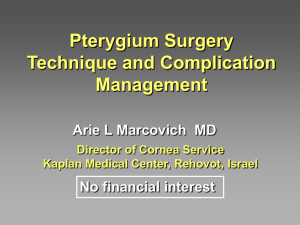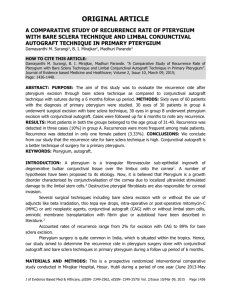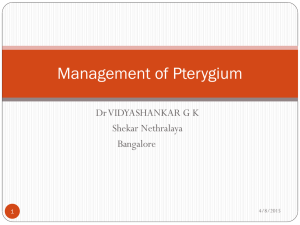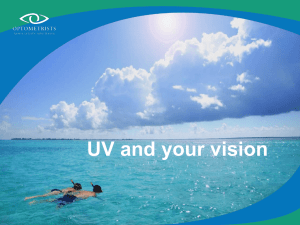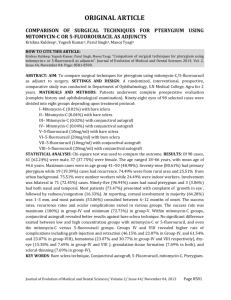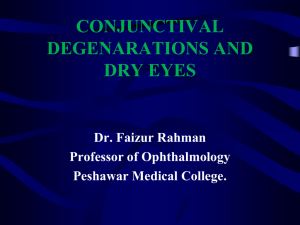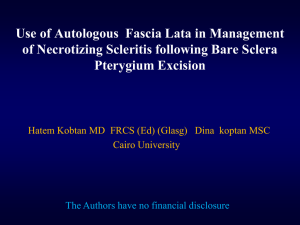A. Venkateswara Rao 1 , DVC Nagasree 2 , Y. Suresh 3
advertisement
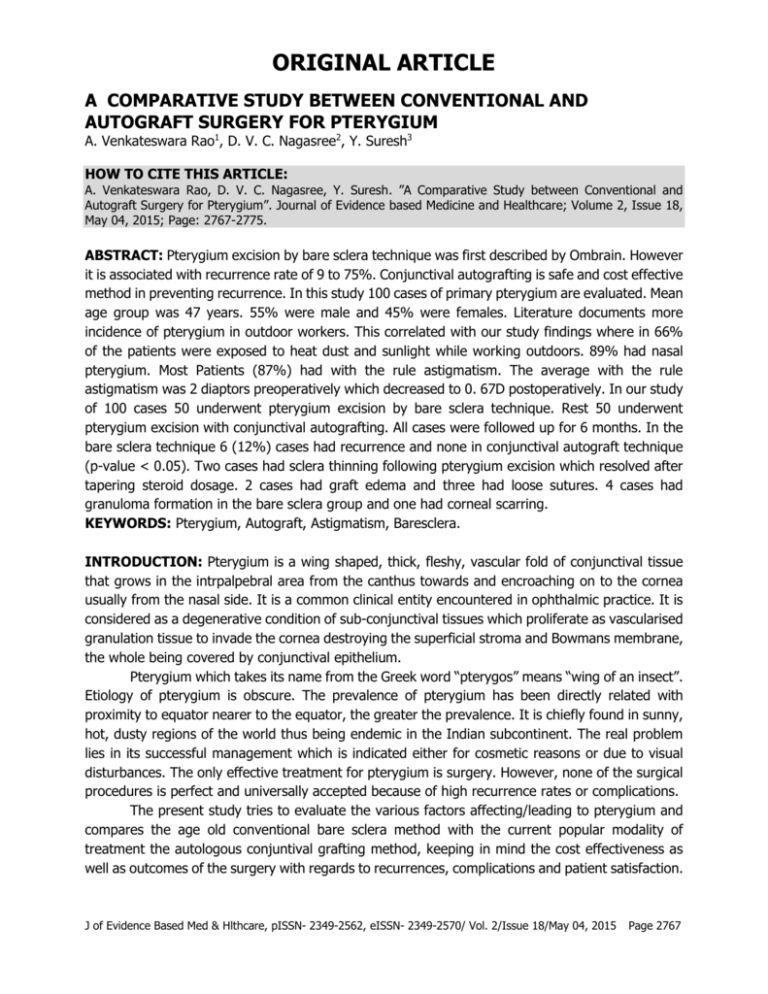
ORIGINAL ARTICLE A COMPARATIVE STUDY BETWEEN CONVENTIONAL AND AUTOGRAFT SURGERY FOR PTERYGIUM A. Venkateswara Rao1, D. V. C. Nagasree2, Y. Suresh3 HOW TO CITE THIS ARTICLE: A. Venkateswara Rao, D. V. C. Nagasree, Y. Suresh. ”A Comparative Study between Conventional and Autograft Surgery for Pterygium”. Journal of Evidence based Medicine and Healthcare; Volume 2, Issue 18, May 04, 2015; Page: 2767-2775. ABSTRACT: Pterygium excision by bare sclera technique was first described by Ombrain. However it is associated with recurrence rate of 9 to 75%. Conjunctival autografting is safe and cost effective method in preventing recurrence. In this study 100 cases of primary pterygium are evaluated. Mean age group was 47 years. 55% were male and 45% were females. Literature documents more incidence of pterygium in outdoor workers. This correlated with our study findings where in 66% of the patients were exposed to heat dust and sunlight while working outdoors. 89% had nasal pterygium. Most Patients (87%) had with the rule astigmatism. The average with the rule astigmatism was 2 diaptors preoperatively which decreased to 0. 67D postoperatively. In our study of 100 cases 50 underwent pterygium excision by bare sclera technique. Rest 50 underwent pterygium excision with conjunctival autografting. All cases were followed up for 6 months. In the bare sclera technique 6 (12%) cases had recurrence and none in conjunctival autograft technique (p-value < 0.05). Two cases had sclera thinning following pterygium excision which resolved after tapering steroid dosage. 2 cases had graft edema and three had loose sutures. 4 cases had granuloma formation in the bare sclera group and one had corneal scarring. KEYWORDS: Pterygium, Autograft, Astigmatism, Baresclera. INTRODUCTION: Pterygium is a wing shaped, thick, fleshy, vascular fold of conjunctival tissue that grows in the intrpalpebral area from the canthus towards and encroaching on to the cornea usually from the nasal side. It is a common clinical entity encountered in ophthalmic practice. It is considered as a degenerative condition of sub-conjunctival tissues which proliferate as vascularised granulation tissue to invade the cornea destroying the superficial stroma and Bowmans membrane, the whole being covered by conjunctival epithelium. Pterygium which takes its name from the Greek word “pterygos” means “wing of an insect”. Etiology of pterygium is obscure. The prevalence of pterygium has been directly related with proximity to equator nearer to the equator, the greater the prevalence. It is chiefly found in sunny, hot, dusty regions of the world thus being endemic in the Indian subcontinent. The real problem lies in its successful management which is indicated either for cosmetic reasons or due to visual disturbances. The only effective treatment for pterygium is surgery. However, none of the surgical procedures is perfect and universally accepted because of high recurrence rates or complications. The present study tries to evaluate the various factors affecting/leading to pterygium and compares the age old conventional bare sclera method with the current popular modality of treatment the autologous conjuntival grafting method, keeping in mind the cost effectiveness as well as outcomes of the surgery with regards to recurrences, complications and patient satisfaction. J of Evidence Based Med & Hlthcare, pISSN- 2349-2562, eISSN- 2349-2570/ Vol. 2/Issue 18/May 04, 2015 Page 2767 ORIGINAL ARTICLE AIMS AND OBJECTIVES: 1. To compare the recurrence rates of pterygium after surgery by conventional bare sclera technique and autologous conjunctival grafting at the end of 6 months of follow up. 2. To compare the postoperative complications, patient comfort and Cosmesis in the two methods after primary pterygium excision. MATERIALS AND METHODS: This study was a prospective study conducted in the Department of Ophthalmology, Katuri Medical College and Hospital, Chinakondrupadu, Guntur during October 2011 to October 2013. It includes 100 patients all presenting with unilateral pterygium of which 50 each underwent the two procedures, conventional bare sclera technique and conjunctival autograft technique for pterygium correction. Inclusion Criteria: 1. Primary pterygium. Exclusion Criteria: 1. Patients too young or too old to undergo surgery. 2. Recurrent pterygium. 3. Atrophic pterygium. 4. History of previous ocular surgery or trauma. 5. Patients with immune system disease, eyelid or ocular surface diseases. 6. Patients on anticoagulants. 7. Follow-up less than 6 months. Preoperative Evaluation: 100 patients were selected for detailed study, encountered during the period of October 2011 to October 2013. Only those patients willing to undergo surgery were taken up for the study. A detailed case history was recorded regarding history, age, sex, occupation, family history and other predisposing factors. A detailed interrogation was made to elicit signs and symptoms to exclude other ocular conditions. Examination: All the patients were examined first with a torchlight and then under a slit lamp. Visual acuity, ocular motility, patency of lacrimal passages and fundus examination findings were noted. The details of the pterygium were noted such as laterality, eye involved, and measured to grade based on Thomas youngson garding based on extent of growth on to the cornea from the limbus. Grading: Grade 1- less than 2 mm. Grade 11- Between 2-3 mm. Grade 111- more than 3 mm. Investigations: Keratometry, intraocular pressure were measured. Routine investigations like blood pressure syringing was done to all the patients’. Patients were put on antibiotic drops before J of Evidence Based Med & Hlthcare, pISSN- 2349-2562, eISSN- 2349-2570/ Vol. 2/Issue 18/May 04, 2015 Page 2768 ORIGINAL ARTICLE the day of surgery. Both procedures were explained regarding the procedure, complications, and recurrence rates. An informed consent was taken. 50 patients who underwent conventional baresclera technique and 50 patients who underwent autograft technique were noted. Anaesthesia: Topical anaesthetic 4% Xylocaine was instilled 3 times at 5 minute interval of 15 minutes prior to surgery. SURGERY: Local infiltration of pterygium tissue with 2%Lignoaine was given. Then either the conventional bare sclera surgery by D’Ombrain technique or excision with conjunctival autologous grafting by Anuga technique was done. Postoperative Treatment: Patients received antibiotic eye ointment on operation table immediately after surgery and then the eye was patched for 24 hours and oral analgesics supplemented for 3 days. After eye patch is removed artificial eye drops 4 times a day along with mild steroid/antibiotic eye drops 4 times a day is given for a period of 1 month, then tapered. An antibiotic ointment is to be applied daily at bedtime. Follow Up: Visits were scheduled at the end of postoperative 1stday, 1st week, 1stmonth, 3rd month and 6th month with particular emphasis on end of 1st week visit to obtain visual acuity, Keratometry as well as the information regarding patient’s cosmetic acceptance or any ocular discomfort. OBSERVATION AND RESULTS: The study population comprised 100 patients. They were diagnosed as various grades of pterygium, depending on the extent of cornea involved. Of the 100 pterygium 50 were subjected to conventional bare sclera technique and 50 to conjunctival autograft technique and followed up for 6 months duration. The following tabulations, a comparative as well as a generalized study were made and charts were plotted. Sex distribution of Pterygium: Among the 100 patients studied 45 of them were female as compared to 55 male patients. Usually pterygium is more frequent in males than females usually due to outdoor work. However in this study males and females were almost equally affected. Distribution of pterygium in various age groups: Pterygium is more common in the age group of 20-40 years. In the current study it was found that more than half the patients belonged to the 30- 50 years age group. Incidence of pterygium based on place of work: In the current study patients involved in Occupation plays a significant role in the etiopathogenesis of pterygium. Pterygium is more common in those who are involved in outdoor outdoor jobs account for two-thirds of the group. Affected eye: In the study pterygium almost equally affected either the left or right eye. J of Evidence Based Med & Hlthcare, pISSN- 2349-2562, eISSN- 2349-2570/ Vol. 2/Issue 18/May 04, 2015 Page 2769 ORIGINAL ARTICLE Laterality of Pterygium: In the current study incidence of nasal pterygium was near 90% compared to about 5%each of either temporal alone or a double pterygium. Grade of Pterygium: Based on the size of pterygium that encroaches on to the cornea it is divided in to 3 grades of which grade2 is seen in almost half the current study group. Presenting Complaints: Over 60% of the study groups chief complaint was foreign body sensation followed by diminished vision and Cosmesis. Analysis of Astigmatism caused by pterygiumon analysis of astigmatism preoperatively, it was found that 87 cases had with the rule astigmatism. This is due to the fact that pterygium causes flattening of the horizontal meridian of the cornea thereby producing with the rule astigmatism. The analysis of degree of astigmatic error due to pterygium showed that, in with rule astigmatism over 40 cases had greater than 2D of astigmatism, 30 had 1-2D OF ASTIGMATISM, 11 HAD 0. 5-1d OF ASTIGMATISM AND 4 HAD LESS THAN 0.5d ASTIGMATISM. While against the rule astigmatism was evenly spread with 4 having less than 0.5D, 2 having 0.5-1D, 3 having1-2D and 2 having more than 2Dastigmatism. The average preoperative with the rule astigmatism in the 87 patients was 2D while postoperatively it was 0.67D i. e. an reduction of 1.33D of astigmatism. The average preoperative against the rule astigmatism in the 11 patients was 1.13D that increased postoperatively to 1.21Di. e. an increase of 0.08D of astigmatism. Both these show that pterygium leads to with the rule astigmatism that to a certain extent is reversed after pterygium excision. Changes in visual acuity: Visual acuity changes noted in the study group include improvement in 29 patients of bare sclera group and 14 patients of auto graft group while it was same in 16 and 32 in same categories while it worsened in 5and 4 patients respectively. Recurrences and Complications: Recurrence was not observed in patients who underwent autograft technique while 12% of bare sclera patients had recurrence within 6 month follow-up period. The p value calculated from Fisher exact test was 0.01 ascertaining that the difference is significant. However complications were noticed in both the groups to nearly the same extent. The chi square test for complications between the 2 groups was 0.09 with a p value of 0.37, including the lack of significant difference in complications rate between the 2 groups. Outcome: The overall outcome was in general good with 70% of bare sclera group patients being satisfied with their cosmetic appearance post-surgery and an equal percent having no ocular discomfort after surgery. The outcome was slightly better in the autograft group where 84% patients gave cosmetic approval and 82% patients had no ocular discomfort. However the chi square test values and p values (2.03, 0.07) show that there is no significant difference between the 2 groups with regards to cosmesis and postoperative ocular discomfort. J of Evidence Based Med & Hlthcare, pISSN- 2349-2562, eISSN- 2349-2570/ Vol. 2/Issue 18/May 04, 2015 Page 2770 ORIGINAL ARTICLE AGE GROUP NUMBER OF PATIENTS <20years 20-30 years 31-40 years 41-50 years 51-60 years >60 years 0 9 23 29 26 13 Table 1: Age distribution OCCUPATION NO. OF PATIENTS Farmer 30 Shepered 13 Labourer 16 Driver 7 Student 5 Teacher 3 Tailor 4 Mechanic 3 Merchant 4 Housewife 11 Unemployed 4 Table 2: Occupational distribution WTR ATR 0-0.5D 4 4 0.5-1D 11 2 1-2D 30 3 >2D 42 2 Table 3: Pre-operative degrees of astigmatism Analysis of various degrees of astigmatism. WTR ATR 0-0.5D 29 4 0.5-1D 6 2 1-2D 2 3 >2D 2 1 Table 4: Various degrees of astigmatism post bare sclera excision J of Evidence Based Med & Hlthcare, pISSN- 2349-2562, eISSN- 2349-2570/ Vol. 2/Issue 18/May 04, 2015 Page 2771 ORIGINAL ARTICLE WTR ATR 0-0.5D 26 0 0.5-1D 13 3 1-2D 2 1 >2D 1 0 Table 5: Various degrees of astigmatism after autografting Visual acuity Same Improved Worsened Conventional 16 29 5 Auto graft 32 14 4 Table 6: Changes in visual acuity Recurrence Complication Conventional 6 (12%) 7 (14%) Autograft 0 (0%) 5 (10%) Table 7: Recurrence and complications Cosmetic Approval No. ocular discomfort Conventional 35 (70%) 35 (70%) Autograft 43 (84%) 41 (82%) Table 8 DISCUSSION: There have been many attempts to optimize Pterygium surgery. Today a wide variety of techniques are in use. The aim is to excise the pterygium and prevent its recurrence which is common with bare sclera technique. Autologous conjunctival transplant avoids the risk of sclera necrosis associated with alternative adjunctive therapies. The relatively lower recurrences with this technique could be due to the transplantation of normal conjunctiva that forms a barrier to the proliferation and advancement of residual abnormal tissue towards the limbus. It was also higher in patients below 40 years of age. The various demographic features and surgical complications are discussed and compared with the results of other studies. Age incidence: According to Cameron, 1965, YoungSon, 1970, Pterygium affects people living in peri equatorial regions.(1) The disease affects preferentially adults over middle age, being relatively rare in children. The highest incidence is in the 4th decade. In a study, it was shown that 87.5% were above the age of 40 years.(2) Another study conducted by,(3) showed that 56. 98% were above the age of 40 years.(2) Present study showed that over 70% were above the age of 40. J of Evidence Based Med & Hlthcare, pISSN- 2349-2562, eISSN- 2349-2570/ Vol. 2/Issue 18/May 04, 2015 Page 2772 ORIGINAL ARTICLE Sex Incidence: Pterygium is more often seen in men than in women. This is due to the fact that men are more exposed to dust than women. In the present study 65 patients were male and 45 patients were female. These results correlate with observations of J. H. Hillger’s 1960,(4) Fernandes, M. Sangwan V. S. , 2005.(5) Occupational Incidence: In the present study two thirds were working outdoors. This fact is well supported by several authors like, Hilgers,(4) and Kerknezov,(6) R. Detels, MD.(7) Pterygium Laterality: In the present study 89 patients had pterygium nasally. This is due to the following factors: sparseness of sub-conjunctival tissue in the temporal region, the temporal region is exposed to a lesser extent to U-V radiation due to greater amount of bowing of outer two-thirds of upper lid.(2) Vision: Visual acuity changes noted in the study group include improvement in 29 of bare sclera group and 14 of autograft group while it was same in 16 and 32 in same category. While it worsened in 5 and 4 patients respectively. It was observed that most patients (87%) had with the rule astigmatism due to pterygium. The average with the rule astigmatism was 2D preoperatively which decreased to 0.67D post operatively. Complications: No major intraoperative complications were encountered in this series. Graft oedema was noted in 2 cases and it responded well to short course of systemic steroids and three had loose sutures that were removed. 2 cases had sclera thinning following pterygium excision which resolved after tapering the steroid dosage. Four cases had granuloma formation I n the bare sclera group and one had corneal scarring. In the bare sclera technique 6(12%) cases had recurrence and none in the conjunctival autograft technique. The p value from fisher exact test showed that this difference was significant. Lewallen s. found that age of the patient was strongly associated with recurrence regardless of which procedure was used. Findings of this study emphasize the importance of randomized controlled trials in assessing the efficacy of specific procedures for pterygium removal,(8) Tan D. T et al,(9) who included 123 primary pterygia showed a recurrence of 2% for autograft and 61% for bare sclera method. Recurrence of Pterygium was more common in grade III pterygia or younger patients. The risk factors for recurrence include geographic location,(10) age,(2,10) and grade of pterygium. Chen P. P et al.(10) who has included 24 primary pterygia for autografting noted recurrence rate of 39% and a complication rate of 10%. Although the present study shows no recurrence for autograft 10% complication rates appears similar. According to Fernandes M, Sangwan V. S. et al. CAG appears to be an effective modality for primary and recurrent pterygia.(5) Males and patients below 40 years face greater risk of recurrence. Bare sclera technique has an unacceptably high recurrence. Prospective studies comparing CAG, CLAG, and AMG for primary and recurrent pterygia are needed.(7) J of Evidence Based Med & Hlthcare, pISSN- 2349-2562, eISSN- 2349-2570/ Vol. 2/Issue 18/May 04, 2015 Page 2773 ORIGINAL ARTICLE CONCLUSION: Pterygium is most commonly seen in adults who are involved in outdoor activity. Nasal pterygium is more likely seen than temporal or double pterygium. Pterygium with 2-3 mm encroachment on to cornea is common. Only effective treatment for Pterygium is surgery. However, none of the surgical procedures are perfect and universally accepted because of high recurrence rates. This study shows that although conventional bare sclera technique is associated with recurrence it is of equal efficacy as conjuctival autografting with regards to cosmetic acceptance and postoperative ocular comfort. While conjunctival autograft technique has low recurrence in accordance with literature it is not without its own complications. Pterygium recurrence is related to pterygium morphology and fleshiness of the pterygium is a significant risk factor for recurrence if bare sclera excision is performed. Conjunctival autografting for primary and recurrent pterygium is effective in reducing pterygium recurrence compared with bare sclera excision.(9) REFERENCES: 1. Cameron ME. Pterygium throughout the world. Arch Ophthalmol. Springfield, III Thomas; 1965; 74 (2): 288. 2. Salagar KM, Biradar KG. Conjunctival autograft in primary and recurrent pterygium: A study J Clin Diagn Re. 2013 Dec; 7 (12): 2825-7. 3. Rao SK, Lekha T, Mukesh BN, Sitalakshmi G, Padmanabhan P. Conjunctival limbal autografts for primary and recurrent pterygia: technique and results. Indian J. Opthalmology. 1998; 46: 203–09. 4. J. H. Ch. Hilgers M. D. Pterygium: Its incidence, heredity and etiology. American journal of ophthalmology Volume 50, Issue 4, October 1960. Pages 635-644. 5. Fernandes M, Sangwan VS, Bansal AK, Gangopadhyay N, Sridhar MS, Garg P, Aasuri MK, Nutheti R, Rao GN. Outcome of pterygium surgery: analysis over 14 years. Eye (Lond). 2005 Nov; 19 (11): 1182-90. 6. Kerkenezov N: A pterygiumsurvery of the far north coast of New South Wales. Trans Ophthalmol Soc. Aust 1956, 16: 110-19. 7. R. Detels, MD, MS; S. P. Dhir, MD, Pterygium: A Geographical Study, Ophthalmol. 1967; 78 (4): 485-491. 8. Lewallen, S. (1989) A randomized trial of conjunctival autografting for pterygium in the tropics. Ophthalmology 96. 11: pp. 1612-1614. 9. Donald T. H. Tan, FRCS; Soon-Phaik Chee, FRCS; Keith B. G. Dear, PhD; Arthur S. M. Lim, FRCS Effect of pterygium morphology on pterygium recurrence in a controlled trial comparing conjunctival autograft with bare sclera excision. Arch Ophthalmol. 1997; 115 (10): 12351240. 10. Philip P. Chen, M. D., Reginald G. AriyasuM. D., VenuKaza, M. D., Laurie D. Labree, M. S., Peter J. McDonnel, M. D., A Randomized Trial Comparing Mitomycin C and Conjunctival Autograft after excision of Primary pterygium, Americal Journal of Ophthalmology August 1995;120(2):151-160. J of Evidence Based Med & Hlthcare, pISSN- 2349-2562, eISSN- 2349-2570/ Vol. 2/Issue 18/May 04, 2015 Page 2774 ORIGINAL ARTICLE AUTHORS: 1. A. Venkateswara Rao 2. D. V. C. Nagasree 3. Y. Suresh PARTICULARS OF CONTRIBUTORS: 1. Professor, Department of Ophthalmology, Katuri Medical College, Guntur. 2. Assistant Professor, Department of Ophthalmology, Katuri Medical College, Guntur. 3. Post Graduate, Department of Ophthalmology, Katuri Medical College, Guntur. NAME ADDRESS EMAIL ID OF THE CORRESPONDING AUTHOR: Dr. D. V. C. Nagasree, Assistant Professor, Department of Ophthalmology, Katuri Medical College, #A, Raghavas Vista, Krishna Nagar, Park Road, Guntur-522006. E-mail: ramakrishna45@yahoo.co.in Date Date Date Date of of of of Submission: 06/04/2015. Peer Review: 07/04/2015. Acceptance: 21/04/2015. Publishing: 04/05/2015. J of Evidence Based Med & Hlthcare, pISSN- 2349-2562, eISSN- 2349-2570/ Vol. 2/Issue 18/May 04, 2015 Page 2775

